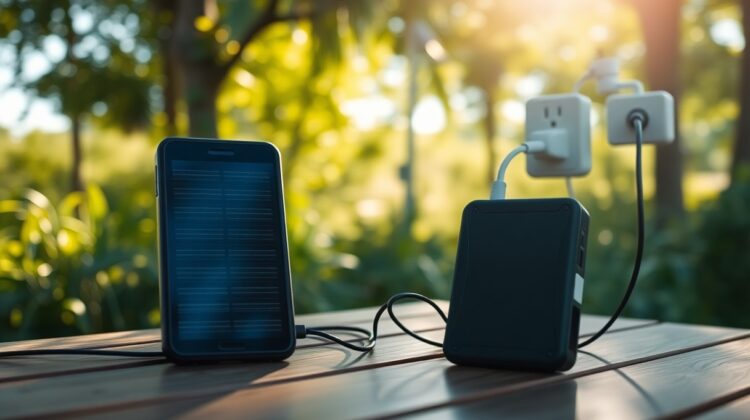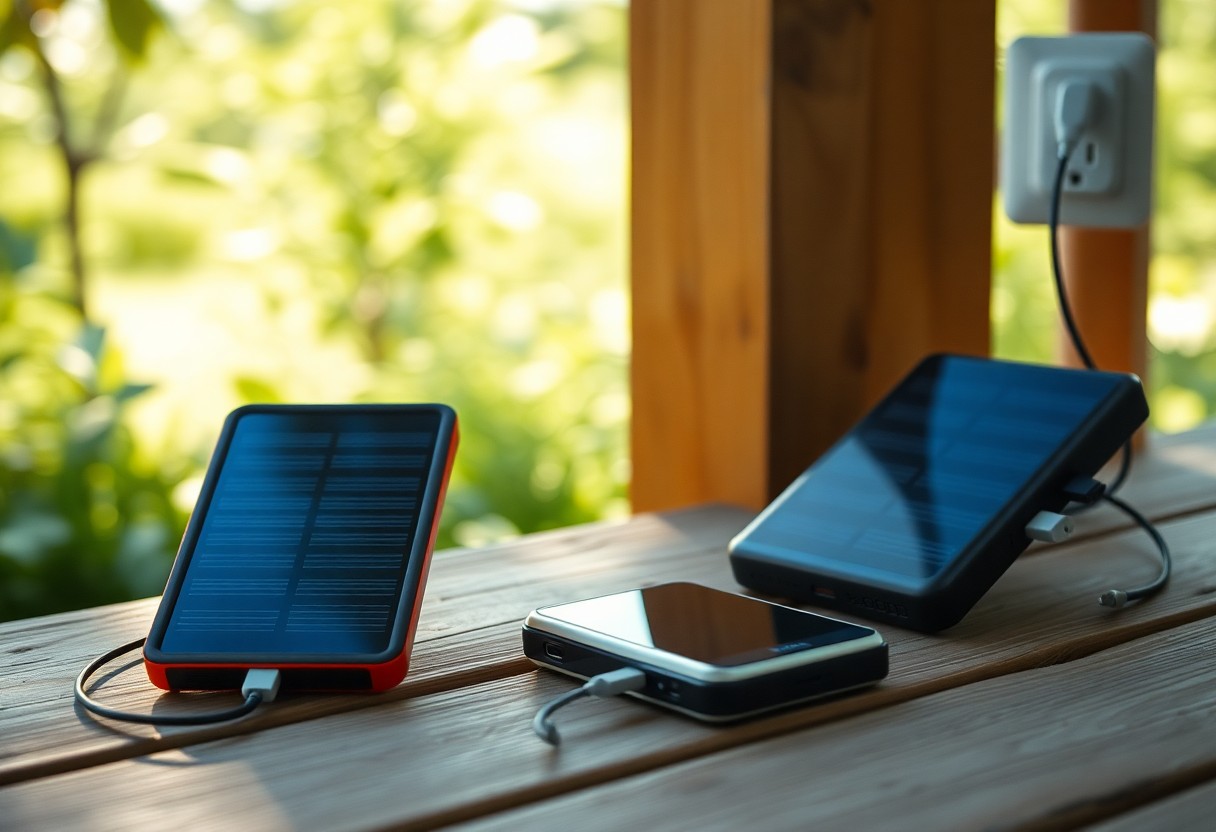
You may find yourself torn between solar power banks vs traditional power banks when considering your portable charging options. Each type offers distinct advantages, depending on your lifestyle, charging needs, and environmental preferences. By comparing their functionalities, efficiency, and convenience, you can determine which power bank best suits your daily activities and outdoor adventures. This guide will help you make an informed decision that aligns with your specific requirements and values.
Understanding Power Banks
To make the right choice between solar power banks and traditional power banks, it’s important to grasp their functionalities. Power banks serve as portable battery packs designed to charge your devices when you’re away from conventional power sources. Both types can prolong the life of your gadgets, but they operate differently, each emphasizing convenience and mobility in unique ways.
What is a Traditional Power Bank?
Banking on the reliability of lithium-ion or lithium-polymer technology, traditional power banks store electricity that you can use to charge your devices on the go. These portable chargers come in various capacities, allowing you to power up multiple devices, like smartphones and tablets, quickly and efficiently anytime, anywhere.
What is a Solar Power Bank?
Below, you’ll discover that solar power banks harness sunlight to recharge their internal batteries, making them an eco-friendly option for charging on the move. Often equipped with solar panels, they are ideal for outdoor enthusiasts who frequent places without easy access to electrical outlets.
Further, solar power banks are designed to provide an alternative charging solution while you’re outdoors. They usually include a standard battery that stores energy collected from sunlight, allowing you to recharge your devices even in remote locations. However, keep in mind that charging efficiency depends on available sunlight and may vary; therefore, it’s advisable to assess how often and where you plan to use them for the best fit for your lifestyle.
Advantages of Traditional Power Banks
Some of the key advantages of traditional power banks are their reliability and immediate availability. Unlike solar generators, which depend on sunlight, traditional power banks can be charged beforehand and used any time, making them ideal for spontaneous trips or emergencies. You can learn more about the comparison between Portable Solar Chargers vs. Traditional Power Banks to understand their unique advantages.
Portability and Convenience
Beside being compact, traditional power banks are lightweight and can easily fit into your bag or pocket, offering a convenient power solution for daily commutes or traveling.
Charging Speed and Compatibility
Along with portability, traditional power banks often provide faster charging speeds and broader compatibility with various devices, such as smartphones, tablets, and other gadgets.
Due to their advanced charging technology, many traditional power banks can deliver quick charge capabilities that significantly reduce the time it takes to power your devices. Their universal compatibility means you can use one power bank to charge multiple devices, eliminating the hassle of carrying several chargers. This makes them an ideal choice for people on the go who need efficiency without the wait.

Advantages of Solar Power Banks
There’s a growing interest in solar power banks, and for good reason. These versatile devices harness the sun’s energy, making them an excellent choice for anyone who prioritizes sustainability and convenience. By integrating solar technology into your charging solutions, you can enjoy the freedom of being outdoors without worrying about draining your power supply. Whether hiking, camping, or just enjoying a sunny day at the park, solar power banks ensure that you stay charged while reducing your carbon footprint.
Eco-Friendly Energy Source
Behind every solar power bank is a commitment to using renewable energy. You tap into clean solar power rather than relying solely on the grid, making it an environmentally responsible choice. This commitment helps to reduce reliance on fossil fuels and lowers greenhouse gas emissions, allowing you to embrace a more sustainable lifestyle with your technology.
Independence from Electrical Outlets
Between traditional power banks and solar power banks, the latter provides you with greater autonomy in charging your devices. When you choose a solar power bank, you gain the freedom to charge anywhere there is sunlight without needing to locate an electrical outlet. This capability can be especially beneficial during outdoor adventures, where access to power sources may be limited.
Independence from electrical outlets means you can explore remote locations without the anxiety of losing power. You can set up your solar power bank in direct sunlight, allowing it to replenish your devices while you enjoy your activities. This flexibility empowers you to stay connected wherever you are, ensuring your necessary gadgets remain charged, while seamlessly integrating into your outdoor experience.
Disadvantages of Traditional Power Banks
After considering your options, you may find that traditional power banks come with certain drawbacks. Whether it’s the need for regular charging or a lack of durability, these devices can fall short of expectations. If you’re looking for a more sustainable solution, you might want to explore Solar Charger vs. Power Bank: Which One to Choose? to weigh your options thoroughly.
Battery Lifespan and Durability
Any device you choose should be reliable, and traditional power banks often have a limited lifespan. Over time, their batteries can degrade, reducing their efficiency and capacity. If you’re frequently on the go, this could lead to frustrating situations where your power bank doesn’t hold a charge when you need it most.
Ongoing Charging Needs
Around the clock, traditional power banks require you to keep them charged, which can be an inconvenience. Unlike solar counterparts, they don’t harness natural energy, leading you to rely on wall outlets, which may not always be available when you need them.
Considering your active lifestyle, you might find that the constant need to recharge a traditional power bank is less than ideal. If you spend time in areas without reliable power sources, you could be left with a dead device. This ongoing charging need could significantly limit your flexibility and independence, especially during travel or outdoor adventures.
Disadvantages of Solar Power Banks
Despite the many advantages of solar power banks, there are notable drawbacks to consider. They generally have a slower charging speed compared to traditional power banks, which can be frustrating if you need a quick recharge. Additionally, their efficiency hinges on sunlight access, which may not be reliable in cloudy or indoor conditions, leading to limited usability for your devices.
Charging Efficiency and Speed
Besides being slower, solar power banks often struggle to deliver the consistent charging performance that traditional power banks provide. This inefficiency can be a significant drawback, especially when you are pressed for time or across a busy travel schedule. You may find that your devices take considerably longer to charge, which can be impractical in urgent situations.
Weather Dependence and Limitations
Behind the convenience of solar power lies a significant limitation: its dependency on weather conditions. If you find yourself in an area with little sunlight or poor weather, the effectiveness of your solar power bank diminishes rapidly.
This means that on overcast days or during long indoor stays, you may struggle to harness sufficient solar energy to keep your devices charged. The reliance on sunlight can be a major inconvenience, particularly if you are outdoors during unpredictable weather or if you’re in environments with limited daylight. This factor can adversely affect your ability to rely on solar power banks for any prolonged use.

Choosing the Right Power Bank for Your Needs
All users have different requirements when it comes to power banks, making it imperative to assess your specific needs before making a decision. Consider factors such as charging capacity, portability, and charging speed to find a power bank that aligns with your lifestyle and usage habits. Be sure to evaluate whether you’re often outdoors, on the go, or if you primarily need a device for home use to help guide your choice between solar and traditional options.
Lifestyle Considerations
Your daily routine plays a significant role in determining the right power bank for you. If you’re frequently outdoors or traveling, a solar power bank might be your best bet for on-the-go charging. Conversely, if you mainly charge devices at home or in urban settings, a traditional power bank may prove more convenient.
Usage Scenarios
Power banks can serve various needs, whether at home, traveling, or during outdoor adventures. When assessing your options, consider how often you require power, the devices you’ll be charging, and the typical duration you’ll be away from a power source.
In addition to your lifestyle, the specific scenarios in which you plan to use a power bank should be factored into your decision-making process. If you often travel for extended periods without access to reliable power outlets, a solar power bank could offer you peace of mind with its capacity to harness sunlight. Alternatively, if you require rapid charging in a more urban environment, a traditional power bank with a high-capacity battery may suit your needs better. Depending on how you use your devices, one option may stand out as the most suitable for your lifestyle.
To wrap up
Presently, when deciding between solar power banks and traditional power banks, consider your lifestyle and power needs. If you frequently find yourself outdoors or in situations where electrical outlets are scarce, a solar power bank may be the right choice for you, offering sustainable recharging options. However, if you often require quick, reliable charging with minimal hassle, a traditional power bank could better suit your needs. Ultimately, understanding your usage patterns will guide you to the most suitable option, ensuring that you stay powered up no matter where you are.
